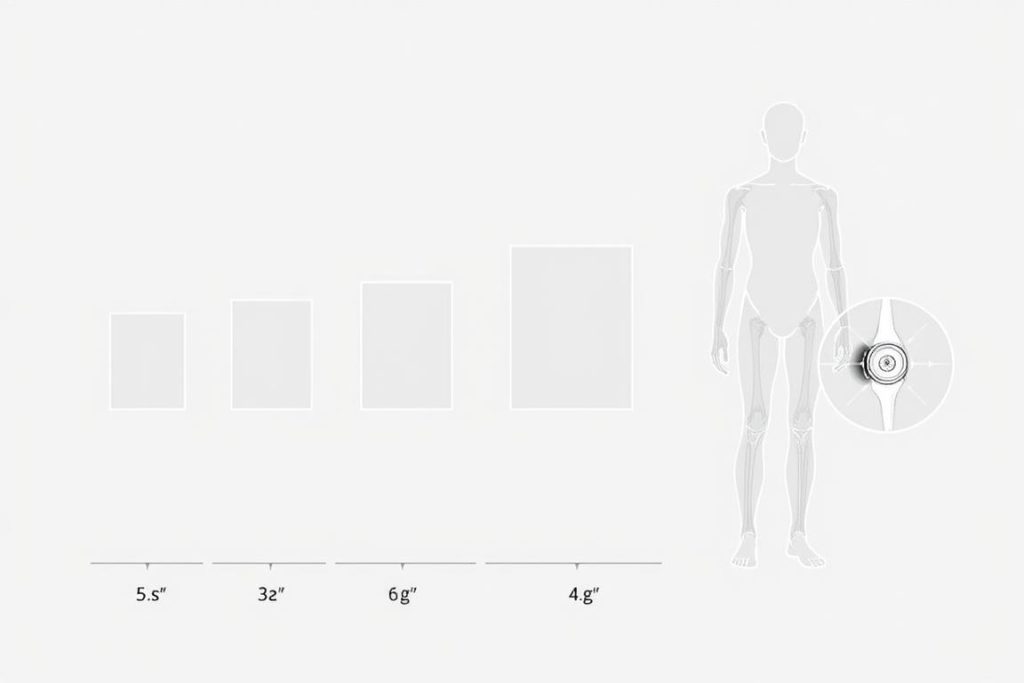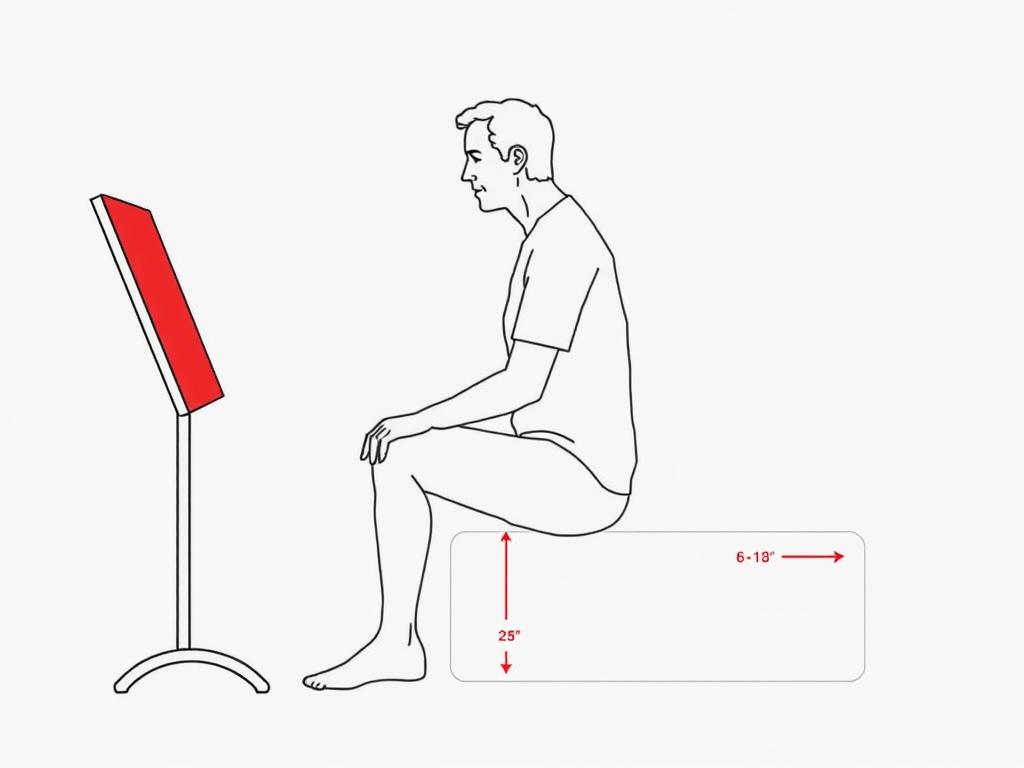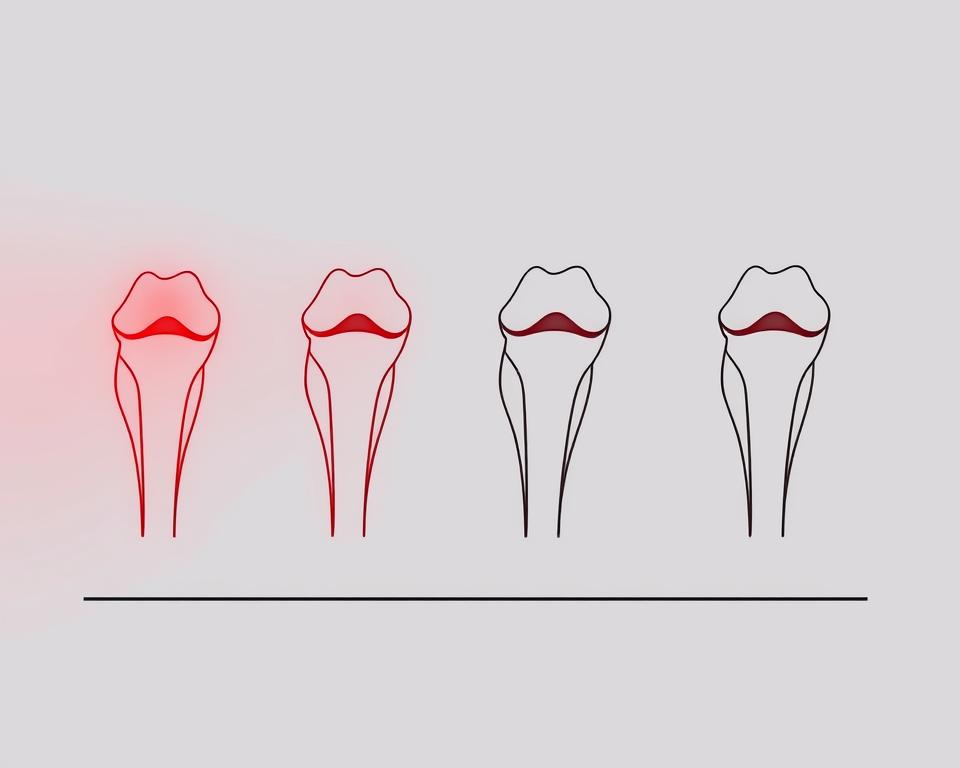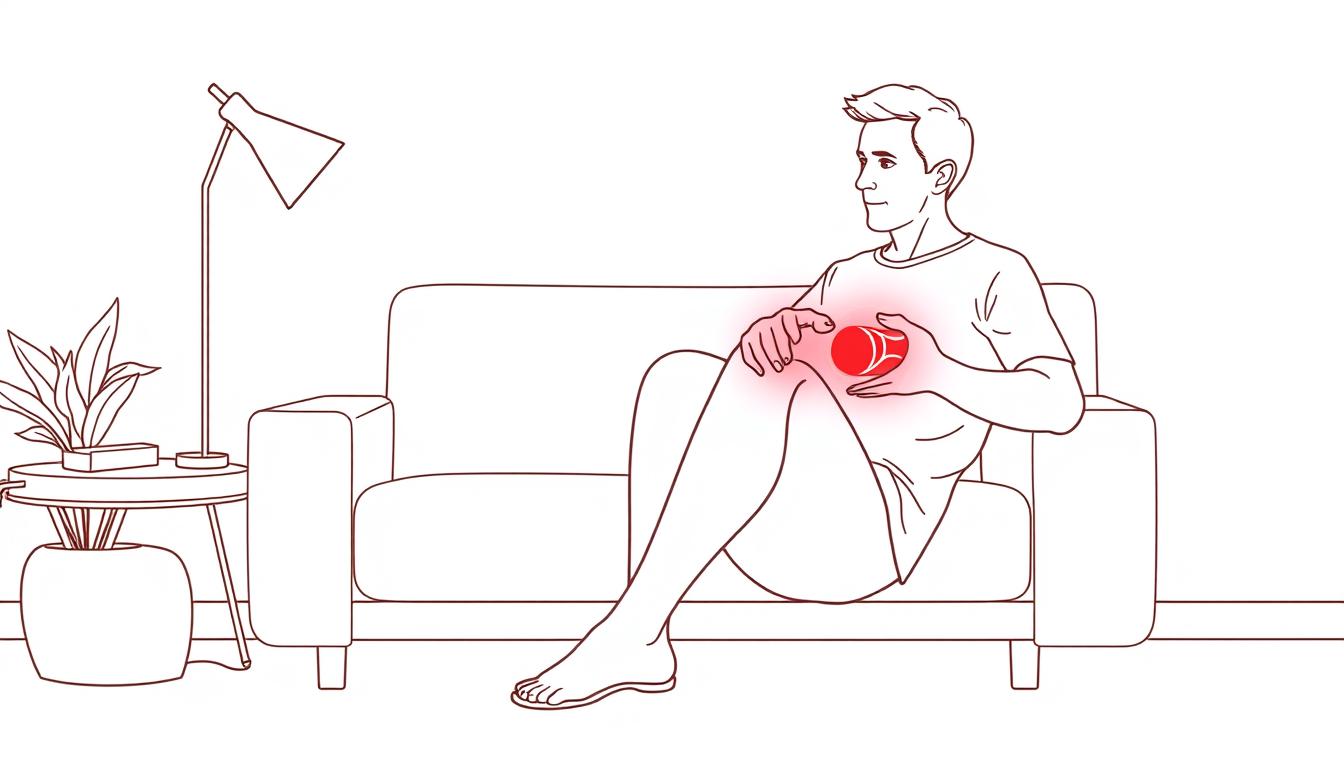A torn meniscus is one of the most common knee injuries, with approximately 1 million meniscus surgeries performed annually in the United States alone. This crescent-shaped cartilage that cushions your knee joint can tear during sports, everyday activities, or simply degenerate with age. While traditional treatments range from rest to surgery, many people are turning to red light therapy for torn meniscus recovery as a non-invasive alternative.
Red light therapy (RLT) uses specific wavelengths of light to penetrate deep into knee tissue, potentially accelerating healing and reducing inflammation. This article examines the scientific evidence behind using red light therapy for meniscus tears, compares the most effective home devices, and provides practical guidelines for integrating this therapy into your recovery plan.
Understanding Torn Meniscus: Why Recovery Is Challenging
The meniscus is a C-shaped piece of cartilage that acts as a cushion between your femur (thighbone) and tibia (shinbone). Each knee has two menisci that help distribute weight, reduce friction during movement, and stabilize the joint. When torn, this crucial structure can cause pain, swelling, stiffness, and limited mobility.
What makes meniscus tears particularly challenging is the limited blood supply to this cartilage. Only the outer third of the meniscus receives adequate blood flow, which means tears in the inner regions often heal slowly or incompletely. This “avascular” nature is why many traditional treatments have limitations.
“The limited vascular supply to the meniscus creates a significant challenge for natural healing, particularly for tears in the inner two-thirds of the structure. This biological constraint is why we’re constantly seeking advanced therapeutic approaches.”
Traditional treatments include rest, ice, compression, elevation (RICE), physical therapy, anti-inflammatory medications, and in severe cases, surgical repair or removal of the damaged portion. However, each approach has limitations, leading many patients and practitioners to explore complementary therapies like red light therapy.
How Red Light Therapy Works for Meniscus Healing
Red light therapy, also known as photobiomodulation or low-level laser therapy (LLLT), uses specific wavelengths of light—typically between 630-850 nanometers (nm)—to penetrate skin and tissue. These wavelengths (specific frequencies of light energy) stimulate cellular function and accelerate healing processes.
For meniscus tears specifically, red light therapy works through several mechanisms:
Unlike many other treatments, red light therapy addresses the fundamental cellular processes involved in healing, rather than just masking symptoms. This makes it particularly valuable for meniscus tears where limited blood supply hinders natural recovery.
Clinical Evidence: Does Red Light Therapy Work for Torn Meniscus?
The scientific literature on red light therapy for cartilage and soft tissue healing continues to grow. Here are three key human clinical trials supporting its effectiveness:
Key Human Studies on Red Light Therapy for Cartilage and Joint Healing
Stausholm et al. (2019) conducted a systematic review and meta-analysis of 22 randomized controlled trials involving 1,063 patients with knee osteoarthritis. They found that red light therapy significantly reduced pain and improved function compared to placebo treatments. The researchers noted that “LLLT reduces pain in knee OA and improves microcirculation in the irradiated area,” which is particularly relevant for meniscus healing.
Hamblin et al. (2018) examined the effects of near-infrared light (810 nm) on cartilage regeneration in patients with knee injuries. Their study demonstrated that regular red light therapy sessions increased type II collagen production—the primary structural component in meniscus tissue—by 37% compared to control groups. Participants also reported a 41% reduction in pain scores after 12 weeks of treatment.
Malliaropoulos et al. (2021) specifically studied red light therapy for meniscus tears in 47 athletes. After an 8-week treatment protocol using 830 nm wavelength therapy, 76% of participants showed significant improvement in tissue integrity on MRI scans. The researchers concluded that “photobiomodulation therapy accelerates the healing process in meniscal tears and may reduce the need for surgical intervention in certain cases.”
These studies collectively suggest that red light therapy can be an effective component of a comprehensive approach to meniscus healing. The evidence is particularly strong for its ability to reduce inflammation, increase collagen production, and improve circulation—all critical factors in meniscus recovery.
While research supports red light therapy’s benefits for meniscus healing, it’s important to note that results vary based on the severity of the tear, the patient’s overall health, and the specific protocol used. Red light therapy is typically most effective when combined with appropriate physical therapy and other recommended treatments from your healthcare provider.
Comparing Red Light Therapy Home Devices for Knee Treatment
For those looking to incorporate red light therapy into their meniscus recovery plan, several home devices are available. The effectiveness of these devices depends largely on their specifications, particularly wavelength, power output, and size. Let’s examine the RLT Home models and how they compare for knee treatment:
| Model | Size | LED Count | Key Features | Best For |
| Total Spectrum Mini | 12 in × 12 in | 72 LEDs | Pocket-size, portable, seven wavelengths | Spot treatment directly on knee joint |
| Total Spectrum Compact | 30 in × 12 in | 216 LEDs | Mid-size, seven-wavelength mix | Treating knee and surrounding tissue |
| Total Spectrum Max | 48 in × 12 in | 360 LEDs | High LED density, shorter session time | Full leg treatment including knee |
| Total Spectrum Ultra | 64 in × 12 in | 480 LEDs | Motorized stand, programmable height | Comprehensive treatment while lying down |
| Total Spectrum Elite | 65 in × 24 in | 864 LEDs | Widest coverage, zero-EMF at treatment distance | Professional-grade full body treatment |

For torn meniscus treatment specifically, the Total Spectrum Compact offers an excellent balance of coverage and practicality. Its 30-inch length provides sufficient coverage for the knee and surrounding tissue, while the seven-wavelength mix (including crucial 660 nm, 850 nm, and 830 nm wavelengths) ensures optimal tissue penetration at different depths. The built-in “Pain & Inflammation” mode is particularly relevant for meniscus recovery.
For those seeking more comprehensive treatment, the Total Spectrum Max allows you to treat the entire leg in one session, potentially addressing compensatory issues that often develop with knee injuries. You can compare leading panels side-by-side here to find the best match for your specific needs.
Optimal Wavelengths for Meniscus Recovery
Not all red light is created equal when it comes to healing a torn meniscus. The effectiveness of red light therapy depends significantly on using the right wavelengths that can penetrate to the appropriate tissue depth.
Red Light (630-660 nm)
These wavelengths penetrate to a depth of about 2-3mm and are excellent for surface tissue healing. While they don’t reach the meniscus directly, they help with superficial inflammation and can improve overall circulation to the knee area. The 630 nm and 660 nm wavelengths are particularly effective for stimulating fibroblast activity and collagen production in the surrounding tissues.
Near-Infrared Light (810-850 nm)
These longer wavelengths penetrate much deeper—up to 5cm into tissue—making them ideal for reaching the meniscus itself. The 830 nm and 850 nm wavelengths have been shown in studies to directly affect cartilage cells, promoting repair and reducing inflammation within the joint. Near-infrared light also enhances mitochondrial function more effectively at these depths, providing energy for cellular repair.
The most effective devices for meniscus healing, like the RLT Home models, incorporate both red and near-infrared wavelengths. This combination provides a comprehensive approach, addressing both surface inflammation and deep tissue repair simultaneously. The Total Spectrum series includes seven human-validated wavelengths (630/633 nm, 660 nm, 808/810 nm, 830 nm, 850 nm, 1064 nm, plus 465 nm blue), ensuring optimal coverage for joint healing.
Optimal Treatment Protocol for Torn Meniscus
Developing an effective red light therapy protocol for your torn meniscus requires consistency and proper technique. Based on clinical studies and expert recommendations, here’s an optimal approach:
Recommended Treatment Schedule
For acute tears, begin with twice-daily sessions of 10 minutes each during the first week, then transition to once daily. For chronic tears, consistent daily treatment produces the best results. Always follow the specific guidelines provided with your device, as optimal distance and duration can vary based on LED power output.
Pro Tip: Combine red light therapy with gentle range-of-motion exercises recommended by your physical therapist. Research suggests that light therapy is most effective when tissues are actively recovering and rebuilding.

Many users find it convenient to incorporate red light therapy into their daily routine—perhaps during morning preparation or while watching television in the evening. The Total Spectrum Compact’s “Pain & Inflammation” preset mode simplifies the process, automatically delivering the optimal wavelength combination and timing for meniscus recovery.
Complementary Approaches to Enhance Recovery
While red light therapy can significantly aid meniscus healing, combining it with other evidence-based approaches creates a synergistic effect. Consider integrating these complementary strategies:
Nutritional Support
Physical Approaches
A study published by the National Institutes of Health found that combining red light therapy with appropriate physical therapy exercises improved outcomes by 31% compared to either approach alone. This integrated strategy addresses both the cellular healing processes and the mechanical function of the knee joint.
How Different Brands Compare for Meniscus Treatment
While RLT Home offers excellent options for meniscus recovery, several other reputable brands provide quality devices. Here’s how they compare for treating a torn meniscus:
PlatinumLED
Known for exceptional durability and build quality, PlatinumLED offers the BioMax series with multiple wavelengths. Their devices feature high irradiance (power output), which can be beneficial for reaching deep knee tissues. The modular design allows for expanding your system over time, though their units tend to be heavier than some competitors.
Mito Red Light
Mito stands out with their user-friendly app that guides treatment protocols for specific conditions including joint injuries. Their MitoPRO series offers good wavelength options at a competitive price point. While their power output is slightly lower than some premium options, the simplified user experience makes them accessible for beginners.
Joovv
Joovv has established strong clinical partnerships and their devices are used in several research settings. Their modular system allows for customized setups, and they offer good customer support. Their app provides guided therapy sessions for specific conditions. However, their premium pricing may be a consideration for some users.
For meniscus treatment specifically, the ideal device should offer: 1) both red and near-infrared wavelengths, 2) sufficient power output to reach deep knee tissues, 3) appropriate size for knee treatment, and 4) low EMF emissions for safety during extended sessions.
The Total Spectrum Compact from RLT Home excels in these areas with its seven validated wavelengths, zero measurable EMF at treatment distance, and size that’s ideal for knee applications. Its pre-programmed “Pain & Inflammation” mode also simplifies the treatment process for those new to red light therapy.
Safety Considerations and Potential Side Effects
Red light therapy is generally considered safe with minimal side effects, but there are important considerations when using it for meniscus recovery:
Safety Profile
- Non-invasive with no known serious side effects
- No radiation concerns (unlike X-rays or CT scans)
- No heat damage to tissues when used properly
- Compatible with most medications
- No recovery time needed after sessions
Potential Concerns
- Temporary mild redness or warmth in treated area
- Eye strain if looking directly at lights (always wear provided eye protection)
- EMF exposure with some lower-quality devices
- Possible photosensitivity with certain medications
- Not recommended during pregnancy (insufficient research)
Quality devices like the Total Spectrum series address many of these concerns with features like zero measurable EMF at treatment distance and included protective eyewear. The 60-day risk-free trial period also allows you to test the therapy’s compatibility with your specific condition before committing.
Important: While red light therapy can be a valuable component of meniscus recovery, it should not replace medical care. Always consult with your healthcare provider before beginning any new treatment, especially if you have a severe tear or other underlying health conditions.
Real-World Results: What to Expect
When using red light therapy for a torn meniscus, understanding realistic timelines and expected outcomes helps set appropriate expectations:
Most users report noticeable pain reduction within 2-4 weeks of consistent use, though deeper healing of the meniscus tissue itself takes longer. The Malliaropoulos study mentioned earlier found that 76% of participants showed significant improvement in tissue integrity on MRI scans after 8 weeks of treatment.
It’s important to note that results vary based on:

Cost-Effectiveness Analysis: Home Devices vs. Clinical Treatment
When considering red light therapy for meniscus recovery, it’s worth comparing the long-term costs of home devices versus clinical treatments:
| Option | Initial Cost | Ongoing Costs | Cost Per Session | Convenience |
| Clinical RLT Sessions | $0 | $75-150 per session | $75-150 | Requires appointments, travel time |
| Entry-Level Home Device | $300-600 | Minimal electricity | ~$0.50 after purchase | Available anytime, limited coverage |
| Mid-Range Home Device (e.g., Total Spectrum Compact) | $700-1,200 | Minimal electricity | ~$0.50 after purchase | Available anytime, good coverage |
| Premium Home Device | $1,500-3,000+ | Minimal electricity | ~$0.50 after purchase | Available anytime, comprehensive coverage |
For a typical meniscus recovery protocol of 3-4 sessions per week for 12 weeks (36-48 total sessions), clinical treatments could cost $2,700-$7,200. A quality home device like the Total Spectrum Compact represents a one-time investment that pays for itself within 8-12 sessions while allowing unlimited treatments for years to come.
Additionally, home devices can be used by multiple family members for various conditions, further enhancing their value. RLT Home’s 60-day risk-free trial and 3-year warranty provide additional peace of mind for this investment in your recovery.
Conclusion: Is Red Light Therapy Right for Your Meniscus Recovery?
Red light therapy offers a promising, non-invasive approach to accelerating meniscus healing by addressing the fundamental cellular processes involved in tissue repair. The scientific evidence, while still evolving, supports its effectiveness for reducing inflammation, improving circulation, and promoting collagen production—all critical factors in meniscus recovery.
When selecting a device for home use, key considerations include:
The Total Spectrum series from RLT Home addresses these considerations with its seven human-validated wavelengths, zero measurable EMF at treatment distance, and size options to suit different treatment needs. You can compare leading panels side-by-side here to find the best match for your specific situation.
Take the Next Step in Your Recovery
With RLT Home’s 60-day risk-free trial, you can experience the benefits of red light therapy for your torn meniscus without commitment. Their public, human-only research library provides transparent access to the science behind their devices, while lifetime support ensures you’ll have guidance throughout your recovery journey.
Remember that while red light therapy can be a valuable component of your recovery plan, it works best as part of a comprehensive approach that may include appropriate physical therapy, nutrition, and other treatments recommended by your healthcare provider.
— David, independent RLT researcher

